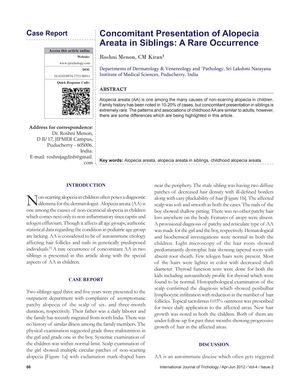Concomitant Presentation of Alopecia Areata in Siblings: A Rare Occurrence
January 2012
in “
International Journal of Trichology
”
alopecia areata AA non-scarring alopecia peribulbar lymphocytic infiltration hair follicles topical tacrolimus autoimmune disease environmental factors genetically predisposed topical treatments steroids immunomodulators thyroid function tests autoantibody profiles hair loss tacrolimus autoimmune genetic factors thyroid tests

TLDR Two siblings both had a rare case of alopecia areata at the same time.
The document reports a rare case of concomitant alopecia areata (AA) in two siblings, a three-year-old girl and a five-year-old boy, who presented with patchy hair loss of different durations. Despite a family history of AA in 10-20% of cases, simultaneous occurrence in siblings is extremely rare. The children, who had recently migrated with their family and were experiencing malnutrition, showed no other family history of similar illness. Physical and systemic examinations were normal, except for signs of malnutrition. Scalp examination revealed non-scarring alopecia with different patterns in each sibling, and their nails and other body hair were mostly unaffected. Hematological and biochemical tests were normal, and thyroid function tests, including autoantibody profiles, were also normal. Histopathological examination confirmed AA, showing peribulbar lymphocytic infiltration and a reduction in the number of hair follicles. The children were treated with topical tacrolimus 0.03% ointment, resulting in new hair growth. The article discusses AA as an autoimmune disease, potentially triggered by environmental factors in genetically predisposed individuals, and highlights the rarity of its concomitant presentation in siblings. It also emphasizes the importance of considering AA in children with hair loss and the need for a thorough evaluation, including psychiatric assessment and routine thyroid screening. Treatment options for AA in children are mentioned, with a preference for topical treatments like steroids or immunomodulators such as tacrolimus.
